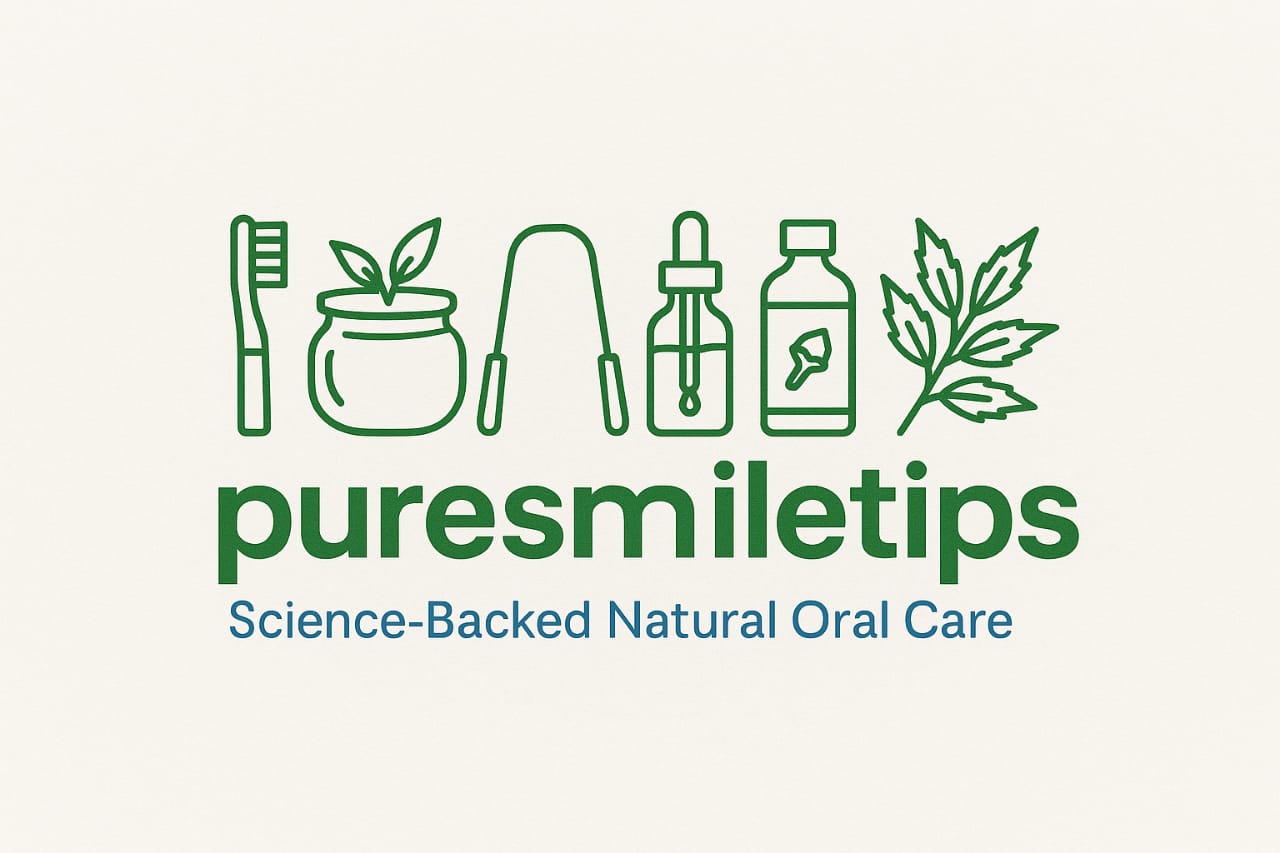Are you searching for genuine, effective ways to strengthen weak enamel naturally? If you’re wondering how to repair tooth enamel naturally at home, you are not alone. Don’t just brush. Floss and see your dentist for a truly healthy mouth. It helps your own body repair and strengthen your teeth from within.
The positive aspect here is that early signs of harm can be undone. Enamel can even get rebuilt through natural means. The resounding answer is yes—and the journey begins not in a dentist’s chair, but in your very own kitchen.
Your enamel is for life. Handle with care. The great news? Taking care of it is simple. You can help your teeth fight back and become stronger every day. These natural ways to strengthen enamel lies in the 17-Step Kitchen Cabinet Cure, a practical guide that moves beyond conventional advice to deliver tangible results.

In this definitive guide, we will cut through the confusion and provide a clear, actionable roadmap to strengthen weak enamel naturally, a process grounded in the science of remineralization and proven nutritional principles.
The critical dietary shift that can halt erosion in its tracks.
The two key minerals your saliva needs to act as a natural remineralizing agent.
How a common cooking oil can be used to reduce harmful bacteria and calm sensitivity.
This goes beyond a simple list of tips. It serves as a real changing plan. One drawn from core ideas in nutrition and natural dentistry. Reading further opens up those seventeen easy steps. They put you in charge of your oral health. They cut back on sensitivity issues. They bring back the natural toughness to your smile.
You can start all this with your next meal. The whole path to a tougher healthier smile lies just a couple scrolls ahead.
How to Strengthen Weak Enamel Naturally: The Simple Science of Healing Your Teeth
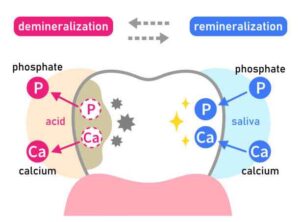
Before diving into the solutions to strengthen weak enamel naturally, it’s crucial to understand what you’re protecting and how your body’s own repair system works. This isn’t a quick fix; it’s a sustainable lifestyle shift that forms the foundation for lifelong dental health.
The Unseen Battle. Understanding tooth enamel.
Your tooth enamel is stronger than any other part of you. Evidence shows it exceeds the strength of bone itself. Tooth enamel is the hardest substance in your body — even stronger than bones. The outer layer looks translucent in appearance. It serves mainly to provide protection for what lies beneath. It endures a full lifetime of activities like chewing, crunching food, and grinding.
Evidence indicates that enamel consists of nonliving cells. As a result, the body cannot repair significant damage or erosion to it. It doesn’t work the same way as a normal cut healing over time.
This is precisely how you can strengthen weak enamel naturally—through the process of remineralization, where minerals like calcium and phosphate are redeposited from your saliva into the enamel, hardening it from within before a cavity can form.
The 5 Silent Saboteurs of Your Smile
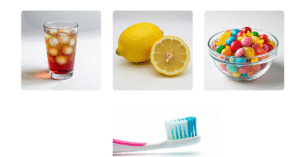
Enemy number one is acid. Acid makes your teeth soft. The real cause is:
Dietary Acids: Citrus fruits, soda, sports drinks, and wine.
Sugar: Sugar feeds harmful oral bacteria, which then produce acid as a waste product.
Stomach Acid: From conditions like acid reflux (GERD) or bulimia.
Dry Mouth (Xerostomia): Saliva is nature’s mouthwash. This protects your teeth.
Abrasive Brushing: Scrubbing your teeth too hard, especially with a hard-bristled brush, can wear enamel away over time.
Your body talks. It’s time to learn what it’s saying.
Listen to Your Teeth: 7 Key Signs Your Enamel Is Weakening
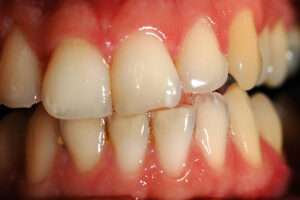
Your body gives you clear warning signs. Is your enamel in trouble? Watch for these signs.
- Temperature Sensitivity: Feel a sudden zap with hot or cold foods? That’s your tooth telling you its armor is getting weak. Inside every tooth is a sensitive nerve. It’s usually covered by a thick, hard layer.
When that layer gets too thin, the nerve is left uncovered. This is what causes that sudden zap of pain from hot or cold foods. Finding an effective natural remedy for sensitive teeth starts by addressing this underlying enamel erosion.
2. Discoloration: Teeth appearing yellow or translucent at the edges.
3. Chips and Cracks: Weakened enamel is more prone to physical damage.
4. Surface Roughness: Your tongue can feel rough spots on your teeth.
5. Shiny Spots: These can be early signs of demineralization.
6. Increased Cavities: As the protective shield weakens, decay sets in more easily.
7. Cupping: Small dents appearing on the chewing surfaces.
Can Tooth Enamel Be Restored? The Science of Remineralization
What’s the goal? The straightforward answer is yes; you can strengthen weak enamel naturally to a significant degree—but not in the way you might think.
Large parts of tooth enamel, once they are lost, do not come back the way skin heals from something like a scrape. Erosion causes real physical harm to that enamel. The damaged area remains missing for good.
Still, the term restoration really points to the strong natural mechanism known as remineralization. Enamel works something like a brick wall in structure. While acids weaken enamel (demineralization), you can strengthen weak enamel naturally by promoting remineralization to rebuild it.
The body reacts by sending over essential minerals like calcium and phosphate directly to that damaged area. That helps with the repair work. Saliva steps in to bind those elements together. It works a lot like mortar securing bricks in a structure.
As a result, small pits and fissures become sealed, which is a key part of the process to strengthen weak enamel naturally. The tooth regains its strength and overall integrity. Early signs of decay, those white spots that show up first, can even be turned around through this. Enamel ends up much tougher as a result, with less sensitivity and no room for more harm to take hold.
How to Stop Enamel Erosion in Its Tracks
While your body can repair enamel through remineralization, prevention is the ultimate key. First, stop the damage. Then, start the repair.
Manage Acidic Foods & Drinks: Consume acids only with meals and rinse with water immediately after. Always wait 30 minutes before brushing to avoid scrubbing softened enamel.
Cut Off Sugar: Sugar feeds the bacteria that produce enamel-eroding acid. By choosing to drink without sugar, you take a critical step to strengthen weak enamel naturally and create an environment for remineralization.
Promote Protective Saliva: Saliva is your natural defense. Have some xylitol gum. And some water.
Avoid Physical Wear: To effectively strengthen weak enamel naturally, it’s crucial to avoid physical wear. Address teeth grinding with a night guard and always use a soft-bristled toothbrush with a gentle technique to prevent abrasive damage.
Your Smile for Life. It focuses on rebuilding that smile through active steps.
How to Remineralize Teeth at Home: A Practical Framework
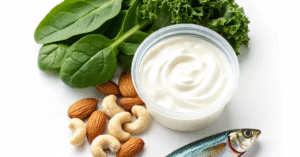
While your body can’t grow new enamel, it is in a constant state of demineralization and remineralization. Enamel works like a wall on your teeth. It gets constantly chipped away in a light way through demineralization. Then repair happens with remineralization.
The ultimate goal to strengthen weak enamel naturally is to shift the balance so that repair consistently outweighs damage. In this process, saliva is the hero, constantly bathing your teeth with essential, strengthening minerals. The entire purpose of the 17-Step Cure is to supercharge this precise, natural repair system.
This comes from giving the mouth the exact materials it needs for the job. It also builds the best kind of setting inside the mouth where healing can really get going.
Convinced? Excellent. Let’s do this. Here’s the plan.
The 17-Step Kitchen Cabinet Cure: Your Action Plan
This cure is divided into four logical parts to systematically strengthen weak enamel naturally by addressing the problem from every angle.
The Best Foods to Remineralize Teeth
Your food shapes you. That idea applies directly to dental health in particular. It pays to concentrate on foods loaded with minerals. Those items supply the key materials the body uses for growth and repair. For a complete, dentist-approved list of the most powerful options, see our guide to the 12 best foods to remineralize teeth.
How to Build Tooth Enamel Naturally with Diet
The most effective way to build tooth enamel naturally is from the inside out. The process of tooth formation relies on providing the body with a consistent supply of essential minerals. These minerals help build the actual structure of teeth.
Studies show that diet acts as the primary way to deliver calcium, phosphate, and various other required nutrients to strengthen weak enamel naturally. Saliva then utilizes these elements to carry out its routine tasks of repair and maintenance.
The Essential Vitamins for Tooth Enamel Strength
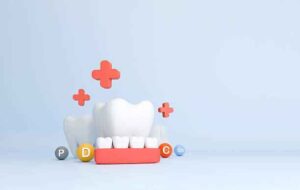
Calcium and vitamins make enamel strong. This function resembles that of project managers in guiding operations. These vitamins direct the placement of the minerals. They help use the materials effectively Focusing on these key players is crucial for any strategy to strengthen weak enamel naturally.
Vitamin D: Think of Vitamin D as the foreman. No vitamin D, weak teeth.
Vitamin K2: To strengthen weak enamel naturally, you need a powerful duo: Vitamin D gathers the building blocks, and Vitamin K2 distributes them. This process is crucial because K2 directs calcium to your bones and teeth, ensuring the minerals go exactly where they’re needed to fortify your enamel.
Vitamin A: This vitamin helps your salivary glands. Your body’s automatic cleanup crew. It’s saliva! A wet mouth is a healthy mouth.
Vitamin C: Collagen plays a key role in building up the dentin—the layer right underneath that tough outer wall of enamel. Since a strong dentin frame provides the essential shape and strength for your entire tooth, supporting it is a fundamental way to strengthen weak enamel naturally from the inside out.
How to Strengthen Weakened Enamel: The First Steps
Time to apply it. Learning how to strengthen weakened enamel begins with these foundational dietary steps. Makes enamel stronger.
Step 1: Embrace The “Calcium Trio”
Enamel is mostly made of calcium.
Why: Repairs and strengthens the enamel lattice.
Action: To strengthen weak enamel naturally, incorporate wild-caught canned salmon with bones, sardines, full-fat organic yogurt, and leafy greens like kale and collard greens into your weekly diet.
Step 2: Harness Phosphorus-Rich Foods
This mineral helps calcium build strong teeth.
Why: Helps maximize the remineralizing benefits of calcium.
Action: A powerful strategy to strengthen weak enamel naturally is to eat eggs, lean meats, nuts, legumes, and pumpkin seeds regularly, as they are rich in phosphorus, a key mineral for remineralization.
Step 3: Activate the “Fat-Soluble Vitamin Key” (Vitamins D & K2)
This is the advanced strategy most articles miss. Vitamin D brings in the calcium. K2 puts it in your bones. Vitamin D is critical for absorbing calcium from your diet.
Why: Without K2, calcium can end up in your arteries instead of your teeth.
Action: To effectively strengthen weak enamel naturally, prioritize getting safe sun exposure for Vitamin D and eating fermented foods like natto, grass-fed butter, and aged gouda for K2.
Step 4: Stop Acidic Foods Before They Start
You can absolutely eat oranges and tomatoes as part of your strategy to strengthen weak enamel naturally. The key is being careful about how much you have and when you have them to maximize their benefits and minimize acid exposure.
Why: Minimizes the duration of acid attacks.
Action: To strengthen weak enamel naturally, a simple strategy is to eat something else before acidic foods. This buffers the acid. Afterwards, just rinse with water for now, and always wait 30 minutes before brushing to protect your teeth.
Step 5: This is the #1 Sweetener to Avoid
All sugar turns out bad for teeth in general. High fructose corn syrup stands out as worse. It feeds those acid making bacteria so easily. They just thrive on it.
Why: It’s a super-fuel for the bacteria that cause demineralization.
Action: To effectively strengthen weak enamel naturally, a critical step is to read labels meticulously and eliminate sodas, sweetened juices, and processed foods containing HFCS.
Step 6: Water: Your Body’s First Defense
While it seems simple, water is one of the most effective drinks to strengthen weak enamel naturally. Water washes away food and acids, and it fuels your saliva—which uses calcium and phosphate to naturally rebuild your enamel.
Why: Maintains a healthy oral pH and promotes saliva production.
Action: Sip water throughout the day, especially after eating or drinking anything, to help strengthen weak enamel naturally.
How to Fix Thin Enamel on Front Teeth
Weak enamel doesn’t just harm your teeth—it also dims your smile. While the fundamental process to strengthen weak enamel naturally through remineralization remains the same, front teeth demand more careful protection. They are the most visible part of your smile and, consequently, face direct acid exposure constantly.
Understanding what causes enamel loss on front teeth is the first step to fixing it. The main causes are:
Be Extra Vigilant with Acid: Use a straw for any acidic drinks to bypass your front teeth.
Soft Brushing is Non-Negotiable: Take your soft brush and move it in gentle circles on your teeth. Use small circles when you brush.
Consider a Hydroxyapatite Toothpaste: This natural mineral works to strengthen weak enamel naturally by mimicking the body’s own biological processes. It effectively fills in microscopic imperfections on the tooth’s surface, which not only makes teeth appear smoother but also reduces their translucency, creating a stronger, healthier-looking smile.
Now that we’ve mastered the internal landscape, let’s optimize your external routine.
Step 7: Ditch the Abrasives: Choosing the Right Toothpaste
Weak enamel is delicate. It can be too strong and wear down your teeth’s natural protection.
Why: Abrasives scratch the enamel surface, making it more susceptible to erosion.
Action: To effectively strengthen weak enamel naturally, switch to a toothpaste with either Fluoride (a proven remineralizer) or Nano-Hydroxyapatite (the natural building block of enamel itself).
Hydroxyapatite vs. Fluoride: Which Remineralizing Toothpaste is Right for You?
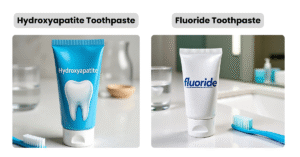
You’ve moved beyond ordinary toothpaste to strengthen weak enamel naturally. Now, for the decisive ingredient. The conversation typically narrows to two powerful options: classic fluoride and biomimetic hydroxyapatite. Your perfect choice ultimately hinges on your personal health perspective and the specific needs of your smile.
The table below provides a clear, unbiased comparison to guide your decision.
| Feature | Hydroxyapatite (HA) | Fluoride |
|---|---|---|
| What It Is | The primary natural mineral that makes up your tooth enamel (97%) and dentin. A biomimetic material. | A naturally occurring mineral that is not naturally present in tooth structure. |
| How It Works | 1. Repair & Restore: Microscopic particles fill in enamel micro-pores and defects directly. 2. Protect: Binds to the tooth surface, forming a protective layer that blocks sensitivity and plaque. | 1. Fortify: Integrates into the saliva and embeds into the enamel structure during remineralization, forming a new, stronger surface called fluorapatite. |
| Primary Benefit | Biocompatible Repair & Sensitivity Relief. Directly rebuilds the tooth’s natural structure. Excellent for reducing sensitivity and creating a smooth, white surface. | Superior Acid Resistance. The resulting fluorapatite layer is significantly more resistant to acid attacks from bacteria, making it a powerful cavity fighter. |
| Best For | • Those seeking a 100% natural approach • Individuals with sensitive teeth • Parents concerned about children swallowing toothpaste • Cosmetic improvement (gentle whitening) | • Individuals at high risk for cavities • Those who want the most proven defense against decay • People with existing restorations or exposed roots |
| Key Consideration | Slightly more expensive than fluoride toothpaste, but price is becoming more competitive. | Some individuals prefer to avoid synthetic fluoride due to personal health considerations. |
The Bottom Line:
Studies point out that both hydroxyapatite and fluoride do their job effectively. They support the remineralization of teeth in ways that prove quite reliable over the long run. Fights cavities.
Choose Hydroxyapatite for a natural, biomimetic approach that focuses on directly rebuilding your enamel in its native form—an excellent strategy to strengthen weak enamel naturally, especially if sensitivity is a major concern.
Fluoride is a shield for your teeth. It creates this kind of shield right on the enamel surface. That shield holds off damage from things like acids and bacteria pretty well. Research points out how the layer stops cavities before they can even get going.
Whichever you choose, consistency is your greatest ally. Using a high-quality remineralizing toothpaste twice daily is a non-negotiable step to strengthen weak enamel naturally in your ‘Kitchen Cabinet Cure.’
Step 8: The 30-Minute Rule: Why When You Brush Matters More Than How
Acid softens teeth, so wait to brush.
Why: Your enamel is in a softened state after acid exposure. Be gentle when you brush.
Action: Always wait at least 30 minutes after eating or drinking to brush your teeth.
Step 9: Introduce an Alkaline Mouth Rinse
An alkaline rinse can quickly fix an acidic mouth.
Why: Rapidly restores a healthy pH for remineralization to begin.
Action: After a meal, rinse with a teaspoon of baking soda mixed in a glass of water, or simply swish thoroughly with water.
Step 10: The Truth About Oil Pulling: Technique & Benefits
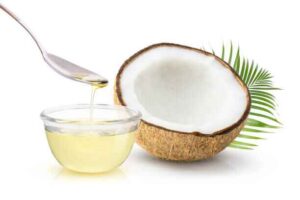
This old method helps fight bad germs and plaque, making it a valuable practice to strengthen weak enamel naturally.
Why: It helps reduce the bacterial load that causes acid and plaque.
Action: Swish 1-2 tablespoons of coconut or sesame oil in your mouth for 10-20 minutes first thing in the morning to strengthen weak enamel naturally. Then, spit it out and brush as normal. [For a step-by-step guide and to see the 6 proven benefits of oil pulling with coconut oil, explore our detailed guide.]
True health is systemic. Your daily routine creates your smile.
Step 11: Heal Your Gut to Heal Your Mouth (The Gut-Enamel Connection)
An unhealthy gut often leads to inflammation in the body. It also messes with how well minerals get absorbed. That issue hits right at the teeth. They cannot fix themselves as they should.
Why: A leaky gut can prevent you from absorbing the Calcium and Vitamins D & K2 you’re consuming.
Action: To strengthen weak enamel naturally, incorporate probiotic-rich foods like kefir, kimchi, and sauerkraut into your diet, and consider adding a quality probiotic supplement to support your body’s innate remineralization processes.
Step 12: Address Silent Reflux (LPR)
A quiet backflow of stomach acid to the throat. This tends to occur often at night. Evidence indicates that the teeth become exposed to the acid during these episodes. The individual remains unaware of the process.
Why: A major cause of unexplained enamel erosion on the back sides of teeth.
Action: If you suspect reflux, see your doctor. Avoid late-night meals and trigger foods like caffeine and chocolate.
Step 13: Break the Nighttime Grinding Habit
Bruxism (grinding or clenching) puts immense physical pressure on your enamel, causing it to crack and wear down.
Why: It’s a mechanical destroyer of enamel.
Action: If you wake up with a sore jaw, talk to your dentist about getting a custom-fitted night guard.
Step 14: Quit Smoking & Limit Alcohol
Both smoking and excessive alcohol consumption drastically reduce saliva production, leading to a dry, acidic mouth environment where enamel cannot thrive. This is why quitting is a critical step for anyone looking to strengthen weak enamel naturally.
Why: They are direct contributors to dry mouth and gum disease.
Action: Seek support to quit smoking and limit alcohol to moderate levels, ensuring you rehydrate with water.
Ready for the advanced protocols? These final steps can significantly accelerate your results.
Step 15: Prepare a Mineralizing Toothpaste
Help your teeth repair themselves.
Why: Provides a direct, concentrated dose of enamel-building minerals.
Action: If you want a formula that is exact and really works, just stick to my weekly routine. It uses this remineralizing toothpaste recipe put together by a dentist. Boost your regular toothpaste by mixing in a pinch of calcium powder. Add a drop of trace mineral liquid too. That makes a strong paste. Use it a few times each week.
Step 16: Simple Xylitol routine.
Simple Xylitol routine. This sweetener starves bad mouth germs.
Why: It disrupts the life cycle of cavity-causing bacteria and raises mouth pH.
Action: To strengthen weak enamel naturally, chew xylitol gum after meals. It boosts your saliva, which neutralizes acid and bathes teeth in protective minerals.
Step 17: Schedule a “Dental Detective” Visit (What to Ask Your Dentist)
Take charge of your smile.
Why: Your dentist is a crucial partner who can spot things you can’t.
Action: Don’t just get a cleaning. Ask specific questions: “Are you seeing any early demineralization? What is the current condition of my enamel? Can you show me on the x-rays?”
How to Make Teeth Strong Naturally: Recapping Your 3-Part Strategy
Strengthen weak enamel naturally with a simple plan: use essential minerals, practice gentle cleaning, adopt smart habits, and seek professional advice. Consistency is your key to success.
You can start seeing real improvements just by trying out a couple of those ideas. Going all in on the full approach hands your body the best set of tools for repairing damage and keeping that smile tough and healthy.
Stop the dental myths. Get the facts.
The Truth About Enamel Repair
Myth: “You can’t regrow lost enamel.“
Truth: Enamel can’t repair itself. Still, remineralizing the enamel that remains works pretty well. You can build it up stronger and harder. That gets it back to a healthy state. It stops additional damage from happening. Early decay even starts to reverse itself.
Myth: “For naturally strong teeth”
Truth: Natural toothpastes often skip the ingredients that are proven to protect your teeth. Ignore the noise. Find what really works.
Myth: “For a gentle clean.“
Truth: Brushing harder is abrasive and damaging. A soft brush cleans best.
Your Journey to a Stronger Smile Starts Now
It is possible to strengthen weak enamel naturally. This guide covers the full range of proven methods, focusing on steady improvement rather than a quick fix. You can begin right now with a few simple choices from the suggestions given, such as drinking more water and waiting 30 minutes to brush after eating.
Choose foods that protect enamel. Small steps, big smile. Everyone holds the ability to manage their mouth health better. In the end, that means creating a smile which looks good and stays solid deep down.
Your confident smile starts with one step.
FAQ: Your Top Questions on Natural Enamel Repair
How do I make my weak teeth strong again?
Good news! 3 simple steps to stronger teeth.
1) Halt the Attack: Immediately reduce your intake of sugary and acidic foods and drinks.
2) Fuel the Repair: To strengthen weak enamel naturally, prioritize a diet rich in calcium, phosphorus, and Vitamins D & K2 to supply the necessary building blocks.
3) Support the Environment: Use a remineralizing toothpaste and maintain excellent oral hygiene to create the ideal conditions for your saliva to heal your teeth.
Just follow this plan to succeed.
Can you rebuild tooth enamel naturally?
Yes, you can rebuild and strengthen the structure of existing enamel through the process of remineralization. This is the fundamental principle of how to strengthen weak enamel naturally. Your saliva helps clean your teeth, constantly delivering strengthening minerals to fix minor damage and build a powerful shield against cavities.
How do you fix weakened enamel?
So, how do you strengthen weak enamel naturally and fix the damage for good? The solution rests on a powerful, three-part strategy:
1) Removing the causes of acid erosion.
2) Fuel your body with better food.
3) Use a toothpaste that repairs your enamel.
The 17-Step Cure in this article is your complete roadmap.
Can you thicken enamel on teeth?
Your body can’t regrow tooth enamel. However, through intense remineralization, you can increase its density and hardness, which makes it functionally stronger and can reduce the translucent appearance associated with thin enamel, making it look healthier.
Can I repair damaged enamel?
How to strengthen your teeth and gums naturally?
The principles are interconnected. You can strengthen weak enamel naturally and protect your gums by eating the right vitamins (C, K2) and minerals (calcium, phosphorus), brushing gently, and staying hydrated.
Conclusion: How to build super strong teeth.

